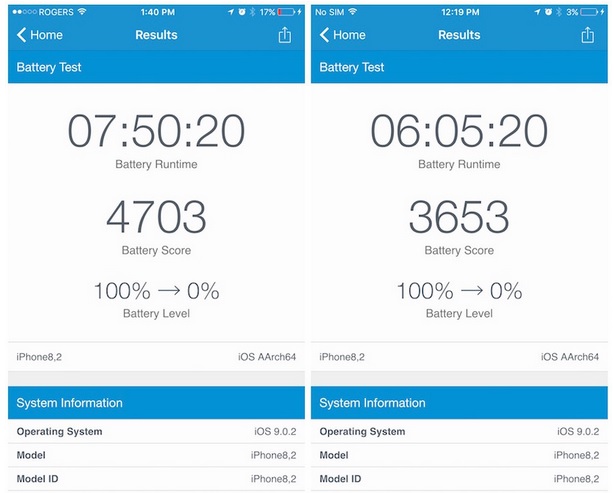Last year, when Apple launched the iPhone 6 and iPhone 6 Plus, the company had a bit of a PR nightmare when ‘bendgate' began making headlines. Now this year, Apple faces a new problem, which is currently being dubbed ‘chipgate'. To put it simply, the A9 processor inside of the new iPhone could be made by one of two companies and performance differs quite dramatically depending on which one you get.
The A9 chips are being manufactured by TSMC and Samsung. Samsung's version uses the 14nm process, while TSMC's uses the 16nm process, which has a direct impact on temperatures and battery performance.

A Reddit posters benchmark findings. TSMC on the left, Samsung on the right.
Right now, tests show that the Samsung A9 chip could have up to 20% worse battery life than TSMC's. The latter company's chip also runs cooler under load. Tech YouTubers, Austin Evans and Jonathan Morrison have released videos of their own findings on the topic, while a Reddit poster has also posted Geekbench battery rest benchmarks to show how big the difference between the two chips can be.
This news is all quite new so Apple has yet to comment on or acknowledge. The issue seems to be that not all iPhone 6s models are built the same, so those looking to buy face a lottery of sorts as there is no way to tell which chip you are going to get ahead of time.
Discuss on our Facebook page, HERE.
KitGuru Says: The TSMC iPhone runs significantly cooler and adds on almost an extra two hours in battery tests. However, it should be pointed out that benchmarks aren't always indicative of every day use. It will be interesting to see if and how Apple responds to this.
 KitGuru KitGuru.net – Tech News | Hardware News | Hardware Reviews | IOS | Mobile | Gaming | Graphics Cards
KitGuru KitGuru.net – Tech News | Hardware News | Hardware Reviews | IOS | Mobile | Gaming | Graphics Cards



so samsungs chips are crappy?
#ChipGate
or maybe just maybe… Samsung are offering crappy chips as a way to move people onto their own phones. They’ve helped Apple out… but they’re still competing companies, would you give the rockstar service to a competitor?
How can 16nm beat 14nm?
It was hardly a particularly scientific test! One has a SIM card in and the other didn’t. So what else wasn’t the same???
Because it’s just a different name, the “16nm” or “14nm” don’t actually mean a size of anything.
Haha, 16nm and 14nm absolutely mean the size of something! It’s the resolution capability of the FAB used.
Basically it means the size of the structures (transistors etc) on the chip.
The problem with chips made in a smaller architecture is that leakage effects in the components will become more prevalent. That could be the reason it uses more power.
nm = nanometres, this indicates the size of the CPU chip. As the chips smaller it generates less heat. Further it appears TSMC have also managed to either cram more transistors on, or just made the transistors more cycle efficient vs Samsung’s tech.
That is patently false, you should be ashamed that you have a AMD logo as a profile.
What I said was correct, the 14nm and 16nm mean exactly nothing. I know that Samsung FinFET is slightly smaller than TSMC FinFET, that’s because the transistor gate pitch is 84nm vs 90nm at TSMC.
If there was some magical number defining the size of everything on a die (as some people here apparently think exists) and that happens to be equal to the naming (14nm or 16nm), then Samsungs chip should be 13.5% smaller, not just 8%.
The matter of fact there is a name that can define the size of everything on a die, its called nanometers.
You obviously don’t know anything about the complexity of a die.
If you want to know something about the differences between TSMC, Samsung, Intel FinFETs, then read some tech articles about them. You’ll quickly see that the naming doesn’t define them. For example these:
About Intel FinFET:
http://www.anandtech.com/show/8367/intels-14nm-technology-in-detail
About A9:
http://www.extremetech.com/computing/215217-samsung-tsmc-both-fab-apples-a9-processor-report
It doesn’t matter what the complexity of a die is. you said 16nm and 14nm doesn’t mean the size of everything when NANOMETER is a measurement to define the size or the length or the width of something.
Hmm I see you’re still making friends Anonymous. I’m afraid m3nace is right. No matter what jargon you throw at it to make things more complex than they are. They’re based on size definement.
What is that “something” everyone here in Disqus comments seem to know about and nobody else does? I’m curious to find out, since all industry and reliable tech site seem to not know either.
“TSMC has opted for the nomenclature 16nm to describe its finFET-based process, which is consistent with the ITRS naming, while GlobalFoundries and Samsung Electronics use the term 14nm.”
The one with sim card lasted even longer
Right but is it really because of the chip or is it because the no SIM device was constantly looking for signal or a SIM card? Can’t really compare if it isn’t done exactly the same.
Made with different processes, surprised? What’s surprising is Samsung’s the under-performer, despite using newer tech. Samsung BS again?
Dude you read that wrong. The one that lasted LONGER had the sim card in there. The Samsung one is so bad, it died even faster than the one that had a SIM card and an active network connection. The SAMSUNG one is the one without the SIM card, and it died 20% sooner.
I repeated that in various forms so you’d understand it.
No. Not true. That’s not how it works anymore. Certain aspects are said to be similar in performance to the stated resolution, but not the overall performance of the product in a linear fashion. If it were that simple, identical A9 chips for example, where the Samung chip is 96mm2 at 14nm, would mean the TSMC one would need to be about 110mm2 at 16nm. But it’s not. Because it’s not as simple as you claim. Just ask Intel.
I know it is super hard for you to understand but I said what I meant. Usually phones that are hunting for signal use more power (duh) so I was questioning if it was from that (moron). Anyways the user ran another test with both in airplane mode which does indeed show the same results so it is not something to do with radio drain but is indeed an issue with the Samsung made SoC.
Except…phones don’t search for a signal without a sim card, unless you use the dial 911 option. How’s it feel to get ridiculed in front of the entire interwebz?
This does not indicate the size of the CPU chip, look up how small a nanometer is and then think again.
No it’s not, it’s the resolution capability, think of it as the tolerance on the intended size of structure